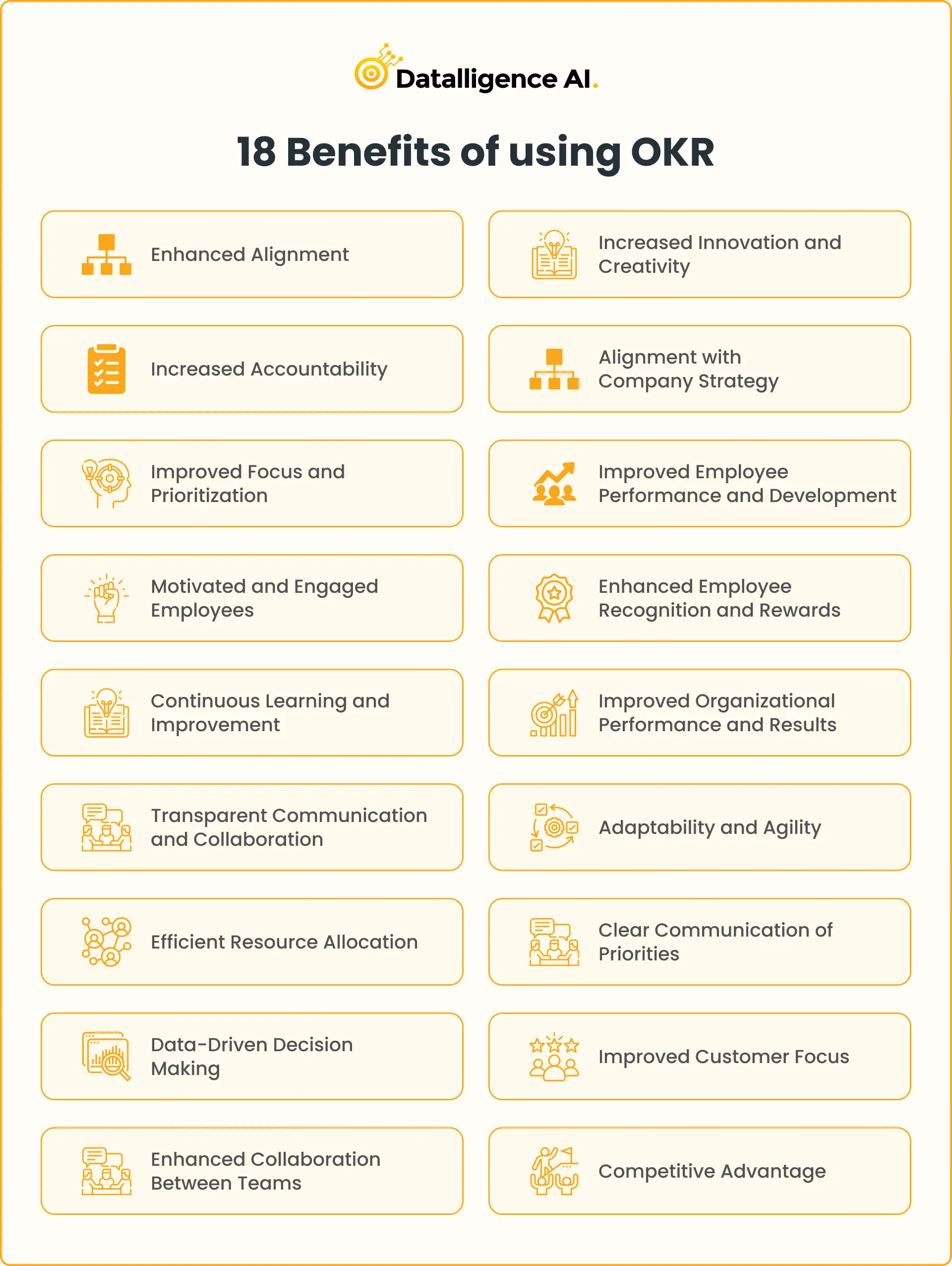Setting goals is essential for any organization, but simply creating objectives without a clear framework and measurement system can lead to lackluster results. That’s where OKRs come in. OKRs, or Objectives and Key Results, provide a goal-setting process that can help teams develop measurable and ambitious objectives. In this article, we will explore the top 18 benefits of implementing OKRs in your organization, ranging from improved alignment and accountability to increased productivity and innovation.
Effective goal-setting is the backbone of organizational success, and in today’s dynamic business landscape, it’s crucial to have a strategy that not only outlines objectives but also offers a systematic approach to achieving them. OKRs have gained popularity for their ability to transform vague aspirations into tangible, measurable outcomes.
Why are OKRs Important
Before diving into the benefits, let’s first understand what OKRs are and how they work. OKRs, which stands for Objectives and Key Results, is a goal-setting framework originally developed at Google and widely adopted by many successful organizations. The framework consists of two components:
- Objectives: These define the desired outcomes that an individual, team, or organization aims to achieve. Objectives should be ambitious, inspiring, and provide direction.
- Key Results: Key Results are measurable milestones or metrics that track progress towards the objectives. They provide a tangible way to assess whether the desired outcomes have been achieved.
OKRs are typically set on a quarterly basis, allowing for flexibility and adaptability in a rapidly changing business environment. They are designed to be transparent, collaborative, and focused on outcomes rather than tasks.
18 Benefits of using OKR

Enhanced Alignment
One of the primary benefits of OKRs is enhanced alignment. When teams and individuals have a clear understanding of the organization’s objectives and how their work contributes to those goals, they can align their efforts more effectively. OKRs provide a framework that ensures everyone is working towards the same overarching objectives, creating a sense of unity and purpose within the organization.
Increased Accountability
OKRs promote a culture of accountability by clearly defining objectives and key results. When individuals and teams have measurable goals to strive for, they are more likely to take ownership of their work and be accountable for their progress. OKRs provide transparency and visibility, allowing leaders and team members to track their performance and take necessary actions to achieve their goals.
Improved Focus and Prioritization
With OKRs, teams and individuals gain clarity on what truly matters. By setting specific objectives and key results, they can prioritize their efforts and focus on what will have the greatest impact on the organization’s success. This eliminates the risk of wasting time and resources on tasks that don’t contribute to the overall goals.
Motivated and Engaged Employees
OKRs have a motivational effect on employees. When individuals have clear and challenging goals, they are more likely to be engaged and motivated to perform at their best. OKRs provide a sense of purpose and direction, empowering employees to take ownership of their work and drive towards success. This increased motivation leads to higher levels of productivity and job satisfaction.
Continuous Learning and Improvement
OKRs foster a culture of continuous learning and improvement. By regularly setting goals and tracking progress, teams and individuals can learn from both successes and failures. OKRs encourage experimentation, risk-taking, and innovation, as individuals are encouraged to find creative solutions to achieve their objectives. This iterative process of setting, reviewing, and adjusting goals leads to continuous improvement and drives organizational growth.
Transparent Communication and Collaboration
OKRs promote transparent communication and collaboration within teams and across the organization. By making goals and progress visible to everyone, OKRs foster a culture of open communication, allowing individuals and teams to share insights, resources, and best practices. This transparency facilitates collaboration and enables cross-functional teams to work together towards common objectives.
Efficient Resource Allocation
OKRs help organizations allocate resources more efficiently. By clearly defining objectives and key results, leaders can identify priorities and allocate resources accordingly. This ensures that resources are directed towards the most impactful initiatives, maximizing productivity and minimizing wasted effort.
Data-Driven Decision Making
OKRs provide valuable data for decision making. By tracking progress against key results, leaders can gain insights into what is working and what needs adjustment. This data-driven approach enables informed decision making and helps leaders make strategic choices based on concrete evidence. OKRs provide a feedback loop that allows for course correction and optimization.
Enhanced Collaboration Between Teams
OKRs foster collaboration between teams by aligning their goals and objectives. When teams have a shared understanding of the organization’s objectives, they can collaborate more effectively, breaking down silos and working towards common goals. This collaboration leads to increased efficiency, innovation, and overall organizational success.
Increased Innovation and Creativity
OKRs encourage innovation and creativity within teams. By setting ambitious goals and key results, individuals are motivated to think outside the box and find new and creative solutions. OKRs provide the freedom to experiment and take calculated risks, fostering a culture of innovation that drives continuous improvement and competitive advantage.
Alignment with Company Strategy
OKRs ensure alignment with the company’s overarching strategy. By cascading objectives from the top level down to individual teams and employees, OKRs ensure that everyone is working towards the same strategic goals. This alignment enhances organizational agility and adaptability, allowing the company to respond effectively to changing market conditions and emerging opportunities.
Improved Employee Performance and Development
OKRs contribute to improved employee performance and development. By setting clear goals and providing regular feedback on progress, OKRs facilitate a growth-oriented mindset. Individuals can identify areas for improvement, seek development opportunities, and track their professional growth. This focus on personal development and achievement leads to higher employee satisfaction and retention.
Enhanced Employee Recognition and Rewards
OKRs provide a framework for recognizing and rewarding employee achievements. By setting specific objectives and key results, it becomes easier to identify and celebrate individual and team successes. OKRs create a culture of recognition, where accomplishments are acknowledged and celebrated, fostering a positive work environment and motivating employees to strive for excellence.
Improved Organizational Performance and Results
The implementation of OKRs leads to improved organizational performance and results. By aligning objectives and key results, fostering accountability, and promoting collaboration and innovation, OKRs drive the achievement of ambitious goals. This improved performance translates into increased profitability, market share, and overall organizational success.
Adaptability and Agility
OKRs promote adaptability and agility within organizations. By regularly reviewing and adjusting goals, teams can respond quickly to changing circumstances and market dynamics. OKRs enable organizations to pivot, seize new opportunities, and stay ahead of the competition in a rapidly evolving business landscape.
Clear Communication of Priorities
OKRs ensure clear communication of priorities throughout the organization. By setting objectives and key results, leaders can effectively communicate what is most important to the organization’s success. This clarity helps individuals and teams align their efforts and make informed decisions about how to allocate their time and resources.
Improved Customer Focus
OKRs drive improved customer focus by aligning goals with customer needs and expectations. By setting objectives and key results that directly impact customer satisfaction and loyalty, organizations can prioritize initiatives that enhance the customer experience. This customer-centric approach leads to increased customer retention, loyalty, and business growth.
Competitive Advantage
Finally, implementing OKRs provides organizations with a competitive advantage. By setting ambitious goals, fostering innovation, and aligning efforts towards strategic objectives, organizations can differentiate themselves in the marketplace. OKRs enable organizations to outperform competitors, drive innovation, and achieve sustainable growth.
Conclusion
In conclusion, the benefits of using OKRs in your organization are vast and impactful. OKRs enhance alignment, clarity, and focus, while promoting transparency, collaboration, and accountability. They drive performance, motivation, and continuous improvement, enabling organizations to adapt to change, make informed decisions, and achieve ambitious goals.
Implementing OKRs can transform your organization by fostering a culture of goal-oriented excellence, empowering employees, and driving overall growth and success. So, take the leap and unlock the full potential of your organization with Objectives and Key Results.
Remember, at Datalligence.AI, we specialize in providing AI-powered solutions that can assist you in implementing and optimizing your OKR process. Contact us today to learn more about how our solutions can propel your organization towards greater success.











